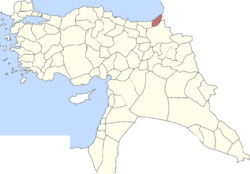Lazistan Sanjak
| Sanjak of Lazistan Lazistān Sancağı | |||||
| sanjak of the Ottoman Empire Under Trebizond Vilayet (1578-1922) | |||||
| |||||
 | |||||
| Capital | Batumi(till 1878) Rize(till 1922) | ||||
| History | |||||
| • | Established | 1578 | |||
| • | Disestablished | 1922 | |||
| Today part of | | ||||
Lazistan (ლაზონა – lazona in Laz, ლაზეთი – lazeti or ჭანეთი – chaneti in Georgian or Turkish: لازستان, Lazistān) was the Ottoman administrative name for the sanjak (under Trebizond Vilayet) comprising the Laz or Lazuri-speaking population on the southeastern shore of the Black Sea. However, its boundaries did not coincide with the Laz-speaking area. It covered the land of contemporary Rize Province and the littoral of contemporary Artvin Province.
._Turkey_in_Asia%2C_Transcaucasia._1861_(EAA).jpg)
The Georgians call Lazistan Chaneti, and the people Chan, plural Chan-ni. The Swanetian form of Chaneti (from which the Turkish Lazistan seems to derive) is Lazan (i.e. La—territorial prefix+Zan<—>Chan). The root form Chan<—>Son is widespread throughout the Caucasus, particularly as applied to tribal and place-names in the western part. The Laz by their language are closely related to the Mingrelians (who are themselves called Chan-ar by the neighbouring people of Swaneti).
.svg.png)
In ancient times, the region was a part of the Kingdom of Colchis. In the Middle Ages, this region was a part of Georgia until 1578 when it was conquered by Turks. In 1878, the eastern portion of Lazistan (including Batumi) became part of the Russian Empire and the centre of the sanjak was moved from Batumi to Rize. After the occupation of the Democratic Republic of Georgia by Kemalist Turkey and Bolshevik Russia (since 1922), the territory has been divided between Turkey and the Soviet Union. The sanjak and name was abolished by the new Turkish Republic in 1925.
Kingdom of Egrisi, known to the ancient Anatolians and Romans as Lazica was known to Persians as Lazistan.
Economy
Historically, Lazistan was known for producing hazelnuts, which were exported to and from Trabzon.[1] Lazistan also produced zinc, producing over 1,700 tons in 1901.[2]
References
- ↑ Prothero, W.G. (1920). Armenia and Kurdistan. London: H.M. Stationery Office. p. 52.
- ↑ Prothero, W.G. (1920). Armenia and Kurdistan. London: H.M. Stationery Office. p. 73.
See also
| Wikimedia Commons has media related to Lazistan. |